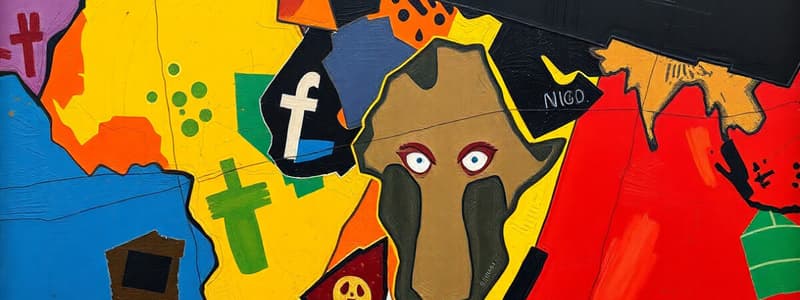Podcast
Questions and Answers
According to G. Popescu, what is the role of borders in rendering space meaningful?
According to G. Popescu, what is the role of borders in rendering space meaningful?
Borders compartmentalize space into two distinctive units.
What are the three main functions of borders in terms of power?
What are the three main functions of borders in terms of power?
- Ideological/political, economic/commercial, strategic/defensive (correct)
- Cultural/ethnic, ecological/environmental, social/religious
- Geographic/territorial, historical/traditional, legal/administrative
- Economic/financial, technological/digital, infrastructural/physical
A binary phenomenon that takes place in borders is the difference between "us" and "them".
A binary phenomenon that takes place in borders is the difference between "us" and "them".
True (A)
Which of the following is NOT considered a function of borders that has emerged more recently?
Which of the following is NOT considered a function of borders that has emerged more recently?
What treaty is cited as an example of how a border allows a state to appropriate its territory?
What treaty is cited as an example of how a border allows a state to appropriate its territory?
According to Martinez's typology of borderlands, which type is characterized by hostility and a lack of interaction between countries?
According to Martinez's typology of borderlands, which type is characterized by hostility and a lack of interaction between countries?
The text argues that all borders are artificial constructs, resulting from human choice and action.
The text argues that all borders are artificial constructs, resulting from human choice and action.
Which of the following is NOT cited as a consequence of European colonialism on indigenous populations in the US?
Which of the following is NOT cited as a consequence of European colonialism on indigenous populations in the US?
What event is considered to have increased the focus on bolstering border security in the US?
What event is considered to have increased the focus on bolstering border security in the US?
In the context of the US-Mexico border, the authors argue that the "Golden Cage Paradox" implies that while a wall may prevent people from crossing into the US, it cannot stop them from returning to Mexico.
In the context of the US-Mexico border, the authors argue that the "Golden Cage Paradox" implies that while a wall may prevent people from crossing into the US, it cannot stop them from returning to Mexico.
Which of the following is NOT an example of how queer people have been marginalized by borders?
Which of the following is NOT an example of how queer people have been marginalized by borders?
What is a key challenge for LGBTQ+ asylum seekers when navigating borders?
What is a key challenge for LGBTQ+ asylum seekers when navigating borders?
The text suggests that "biometric borders" are designed to enhance security by relying on sophisticated technologies for identification and verification.
The text suggests that "biometric borders" are designed to enhance security by relying on sophisticated technologies for identification and verification.
What is the term used in the text to describe the situation where LGBTQ+ people seeking asylum in the US face discrimination in certain states?
What is the term used in the text to describe the situation where LGBTQ+ people seeking asylum in the US face discrimination in certain states?
What is the key argument of the Conclusion section regarding borders and the LGBTQ+ community?
What is the key argument of the Conclusion section regarding borders and the LGBTQ+ community?
Flashcards
Border
Border
A discontinuous line in space that divides and defines areas, creating distinct territories.
Border Power
Border Power
The authority and control exerted by a state over its territory, typically at the border.
Border and Sovereignty
Border and Sovereignty
Borders establish the limits of a state's power and authority.
Border and Identity
Border and Identity
Signup and view all the flashcards
Border Ambivalence
Border Ambivalence
Signup and view all the flashcards
Borderland
Borderland
Signup and view all the flashcards
Sovereignty
Sovereignty
Signup and view all the flashcards
Treaty of Westphalia
Treaty of Westphalia
Signup and view all the flashcards
Decompression of Sovereignty
Decompression of Sovereignty
Signup and view all the flashcards
Border Functions
Border Functions
Signup and view all the flashcards
Alienated Borderland
Alienated Borderland
Signup and view all the flashcards
Co-existent Borderland
Co-existent Borderland
Signup and view all the flashcards
Interdependent Borderland
Interdependent Borderland
Signup and view all the flashcards
Integrated Borderland
Integrated Borderland
Signup and view all the flashcards
Study Notes
Evaluation
- Oral presentation evaluation: interview with NGO using Sarah's methodology
- NGOs working with migrants, women, and indigenous communities
- Semester end: dissertation, week 12 or 13
Course
- Borders: discontinuous in space, create meaning by dividing space into distinct units (G. Popescu)
- Power and Borders: borders define the limits of a state's power and sovereignty. Crossing a border puts a person under the control of another state.
- Identity and Borders: borders maintain national cohesion; a state's external envelope that binds a society and defines citizenship.
- "Difference in Space" (Popescu): a binary concept of "us" and "them" inherent in borders.
- Ambivalent Borders: borders divide and unite. They're both boundaries and interfaces for trade, travel, and interaction (connecting and separating people).
Border Definition
- Boundary vs. Border: Borders are lines, institutions, and border checks.
- Borderland: the region surrounding a border, characterized by its interaction with the border—how it shapes the local culture and environment.
- Frontier: a mobile, expanding, and inhabited line in American history (vs. a fixed line); a French term, "frontiere".
Studying That Suits You
Use AI to generate personalized quizzes and flashcards to suit your learning preferences.




